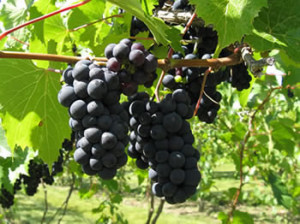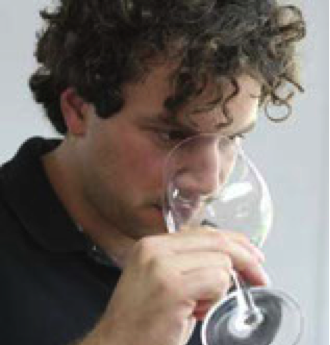Game Changer Grape is a Little Pearl
The 2014 Wisconsin Fresh Fruit and Vegetable Conference led to the typical dissemination and confluence -or occasional clash- of ideas that makes a conference of this nature so infectious. Although, it has been argued that there are too many such conferences in the Midwest, the goal is to leave having learned something new, providing material for future experimentation and execution in the vineyard or winery.
One of the most exciting developments on display at the Conference is the recent development of Petite Pearl, with its refined vinifera-like general chemistry and improved phenolic chemistry.
One man who deserves the bulkshare of the credit for Petite Pearl is Mr. Tom Plocher. Tom has long been a tour de force in the cold climate grape/wine world, co-writing a book dedicated to our unique art-form practiced here in da Nort’ [Northern Winework].
He is also spearheading the international consortium known as Vitinord (vitinord.org). Unbeknownst to most in attendance, Tom has been breeding grapes with some frequency as early as 1983. And recently, Tom added another fine feather in his cap, releasing his new baby — Petite Pearl.
By and large, Petite Pearl left a positive impression on those who were able to sample from various wineries in attendance (this guy included.) Without a doubt, I believe this new variety to be a game changer for cold hardy hybrid winemaker’s who wish to produce an age worthy, dry red. It has been said that Marquette is our Burgundy; could Petite Pearl possibly be our Bordeaux?
The grape chemistry of Petite Pearl has been lauded as being vinifera-like (Brix ranging from 22-24.5, pH of 3.3-3.6 and titratable acidity of 6 — 7 g/L.) In addition, the wine has no labrusca-like or ‘hybridesque” aromas or flavors. On the subject of acidity, a 2009 Petite Pearl wine sample that did not go through MLF had a tartaric acid level of 6 g/L and malic acid as little as 2.2 g/L.
It is not uncommon for the acid levels in hybrid grapes to be in a 1:1 ratio of tartaric to malic acid (or with higher amounts of malic acid) while most V. vinifera’s is typically in a 2:1 ratio. Imagine a red varietal, in our climate, that doesn’t have to go through MFL for proper acid balance!
Although there are other cold hardy hybrids with improved viticultural characteristics (cold hardiness, delayed bud break, disease resistance, etc.) and general grape chemistry (Brix, pH, and TA), it is Tom’s unwavering focus to improving tannin structure in our reds that truly make Petite Pearl stand out from rest.
In past MWP articles, I’ve pointed out the challenges of producing a quality dry hybrid red due to the lack of grape produced tannins and amount of extractable tannins in red hybrid wines.
See related story: Tannin Additions in Red Hybrid Wines
And yet, quantitative validation of the Petite Pearl’s superior chemical profile – grape phenolics included – provides a welcome contradiction, and perhaps a glimmer of things to come.
Tom appears to be taking a cue from research stemming out of Australia, that has found a link between wine quality and phenolic content. This research (Mercurio et al. 2010) pinpoints two measurable parameters that drives improved ratings (quality) in Australian red wines 1) higher amount of total phenolics and 2) a high proportion of those total phenolics represented as tannins (as opposed to anthocyanins or other phenolic subclasses.)
For total phenolics, Petite Pearl is on par with V. vinifera red wines. Quantitative analysis from the Midwest Wine Institute measured values as high as 1300 mg/L in a 2009 Petite Pearl wine. For reference, generalized optimums for total phenolics (quantified as mg of Gallic acid equivalents/L) in V. vinifera for a light and full reds have been listed at 1200 and 1800 level respectively (Kennedy et al., 2006.)
As tannins are typically the most abundant phenolic, Tom listed a key ratio of total phenolics to grape tannin (values derived from MCP tannin assay) as being useful for screening different grape varieties for the capacity to produce quality red wine. Reportedly, total phenolic to tannin ratios for Shiraz grapes in Australia range from 4 — 6, while Petite Pearl grapes measured out at 2.5 — a clear step in the right direction. In terms of how much of those tannins are extracted into wine remains to be seen from a quantitative standpoint, but judging purely from a sensory perspective, I think the proof is in the pudding. The necessary structural backbone is there to make a quality dry red.
Lastly, it should also be noted that another carrot has been dangled. Tom left us with news that there are other non-released varieties that are regularly beating Petite Pearl in blind tastings and these same varieties are similar to the Australian phenolic to tannin benchmark listed above. What that means for us as grapegrowers and winemakers in the future, we’ll have to wait and see.
Piero Spada received his MS from Cornell’s Viticulture and Enology program and was previously a winemaker in the Finger Lakes. Piero is now an independent vineyard and winery consultant based in Wisconsin and can be reached via email at pierospada.com
Tom Plocher varieties may be purchase through:
Beaven’s Creek Vineyard and Nursery (MN)
Northeast Vine Supply (VT)






Great article summarizing Tom Plocher’s presentation at this year conference. I’m really looking forward to tasting more wine’s made from Petite Pearl. Thanks Piero!
Hi Piero was there any discussion as to when Tom might release some of the other varieties??
Jeremy, sorry for the late reply but I just got official word from Tom about when we can expect some of the newer hybrids to be released:
1) TP 1-1-34 Expect some limited availability in 2015, more realistic release in 2016. High tannin content relative to all quantified cold hardy hybrids. TP/ tannin ration of 3. Reminds Tom in style of Sangiovese.
2) TP 1-1-12 Described as Sabrevois nose meets P. Pearl Structure. As such, a Quebec nursery is the first to propagate significant numbers, expected release 2016. TP / tannin ratio of 6.0
3) TP 2-1-17 The sister of Petite Pearl. TP / tannin ratio of 6.0. Lighter color than Petite Pearl. Best used for rose and soft fruity dry reds.
Thanks Tom!
Cheers,
Piero
Hi Piero
Thanks for the responce. This is pretty exciting news! I cant wait to see the outcome. I wish I could get my hands on some of the TP 1-1-12 vines a little sooner than 2016.
Good article. Like racehorses, though, the bloodline is always of interest and was not mentioned. What are the parents and which wild varieties are involved? Thanks.
Hi Lucian,
Good point! Does anyone know for sure with Chambourcin? I’d like to know too…if any Chambourcin grape nerds can help out, please let us know.
kind regards
Danny
(using Mark’s log-in)
Lucian,
Like most “neo” hybrids of today, the pedigree of Petite Pearl is rather complex but Petite Pearl’s parents are MN 1094 and E.S. 4-7-26.
Cheers,
– Piero
Great summary Piero. I also tasted wine from Petite Pearl at the conference and was blown away in comparison to Frontenac and Marquette. Producers were Vines and Rushes from Ripon and Parallel 44 from Door County, who aged it on oak for a while (don’t know how many months). Lucian, you can see the parentage of Petite Pearl on Tom’s website. Can’t wait for more releases.
I heard Tom’s presentation, & tasted Petite Pearl wine at the conference. It convinced me to order Petite Pearl vines, & I plan on pulling my existing Marquette vines. These are exciting times for those making wine with cold climate grapes. Great article Piero.
Happy to see progress being made with the new-generation hybrids. An exciting future lies ahead. The first hybrid that turned me onto wines from interspecific varieties was Foch, and I still like it – though here in Ontario, it’s getting hard to find. For some reason, Baco remains huge in Ontario, even though Foch is the better of the two for acid/tannin balance (qualitatively speaking). I find that Frontenac tastes much like Baco, while Marquette has a very nice tannic edge to it. Noiret, from NY State, is excellent – though no winery in Ontario has it. Noiret smells like Syrah but looks like Chambourcin due to its pigmentation. Haven’t yet tried Petite Pearl – I don’t think anyone this side of the border grows it (yet).